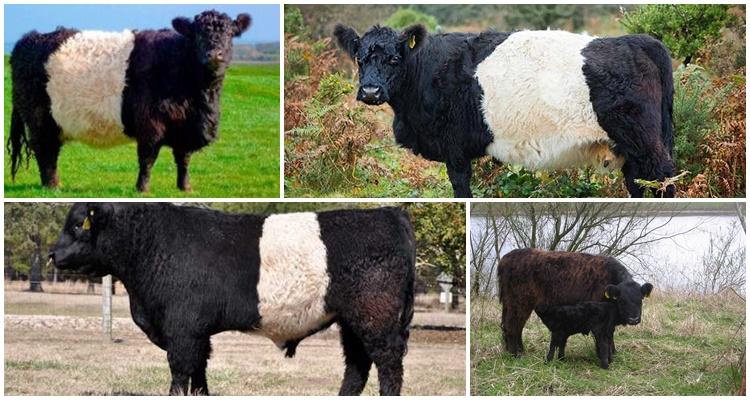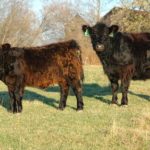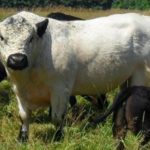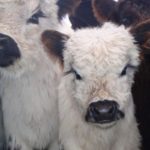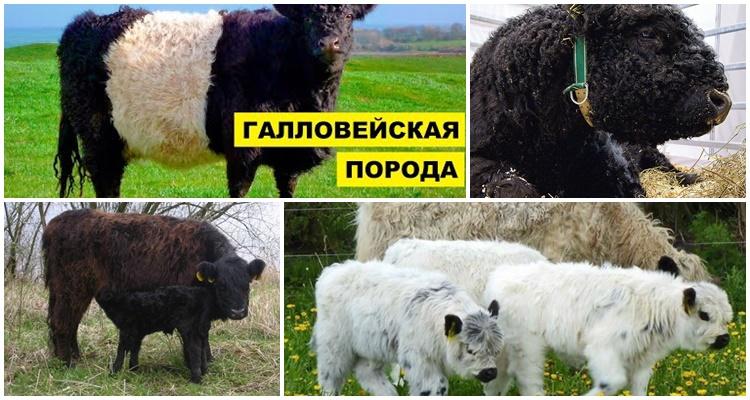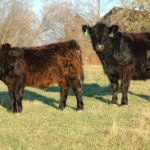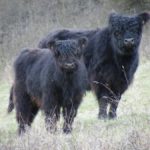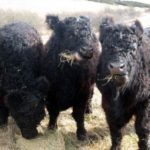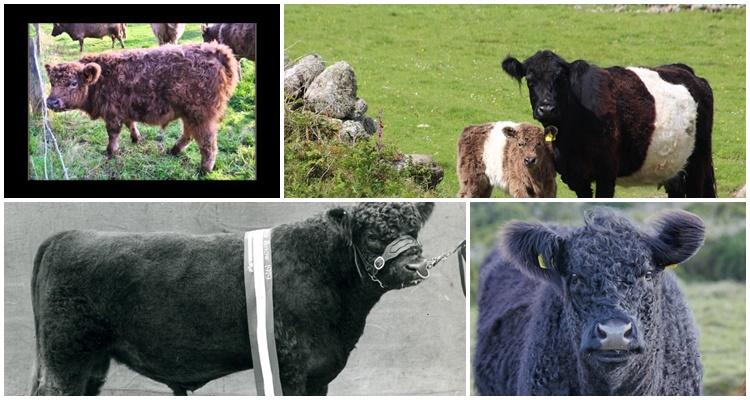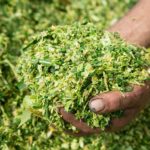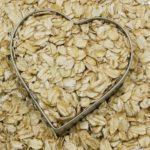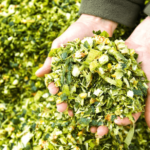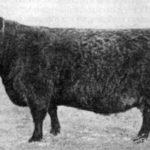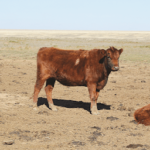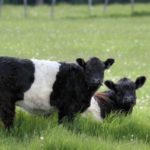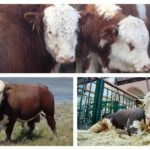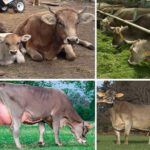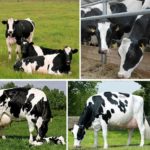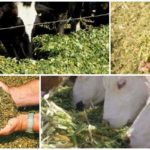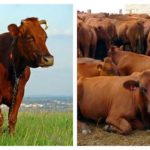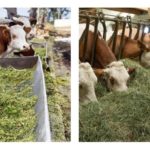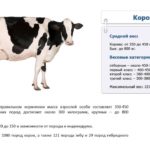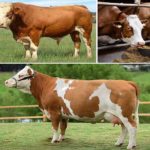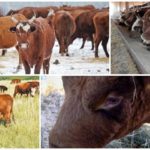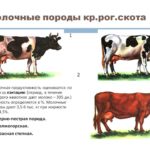Galloway cows were bred in Scotland. This type of livestock is bred primarily for meat, since the weight of an adult bull reaches 850 kilograms, and that of a cow – 550 kilograms. Galloway animals are hardy, unpretentious, capable of growing quickly in harsh conditions, they are characterized by ease of calving and attachment to the herd. This makes the Galloway breed popular in many countries around the world.
- Origin of the breed
- Description and characteristics of Galloway cows
- Main positive and negative aspects
- How to keep and care for animals
- Summer playground
- Arrangement of the premises
- Conditions of detention
- Regular cleaning of stalls and equipment
- What to feed
- In summer
- in winter
- Water
- Subtleties of breeding
- Diseases and their treatment
Origin of the breed
The Galloway cattle breed is one of the older types of cows that are raised for meat. Initially in Scotland, in the county of Galloway (where the name of the breed came from), the cattle had a meat and dairy direction, later it was changed to pure meat as a result of selection.
Cattle were bred in mountainous areas, in conditions of high humidity, cool summers and winters with little snow. The breed began to be bred around 1850, and later the Galloway Cow Breeding Society was created. In 1878, the first part of a breeding publication about Galloway cattle was published, and 4 years later a union of breeders of the breed was formed in Chicago. The largest amount of literature on the peculiarities of raising Galloway cows was also published there.
In Russia, not many farms are engaged in breeding Galloway cows; this type of cattle accounts for 0.6-0.8% of beef breeds. The location of the breeding stock is in the Altai experimental farm of the SB RAS.
Description and characteristics of Galloway cows
Galloway cattle resemble Aberdeen Angus cattle in appearance, but have a longer and shallower body. The body of bulls and cows is covered with thick hair of a dark (black or brown, mixed with gray) color. In rare cases, calves are born with a light stripe on their body, pure beige or white.
In winter, the thick and coarse hair of Galloway animals reaches a length of 20-25 centimeters, thanks to which the cows do not freeze in unfavorable climatic conditions. They can graze outdoors almost year-round. Galloway cattle are not afraid of rain, snow, or wind.
In hot conditions, cows also do not experience discomfort, since wool perfectly performs thermoregulatory functions and prevents the body from overheating.
Thanks to constant grazing, the cattle have developed a powerful, muscular body with a strong constitution. The neck and chest are wide, the lumbar region is short, the back is flat. The legs are short, the hooves are stable and dense. The head is lumpy. In Galloway cows, calving occurs easily, and maternal qualities are highly developed. Cattle are tied to the herd.
A calf at birth weighs 25-30 kilograms, adults reach a large weight:
- cows – 450-550 kilograms;
- bulls - 750-850 kilograms.
A one-and-a-half-year-old bull, under good housing and feeding conditions, already weighs 400-450 kilograms. The slaughter yield of a fattened bull reaches 65%. Cows produce up to 1,500 liters of milk per month with a fat content of about 4%.
Main positive and negative aspects
Cows of the Galloway breed, or, as they are popularly called, Golovey cattle, have many advantages:
- Endurance and undemanding to special conditions. To maintain meat and milk productivity at a high level, Galloway animals only require succulent feed for a long time. The herd does not need to make special pens when grazing on pastures - the cows do not move further than a meter from each other.
- Absence of labor-intensive processes in the content. It is important to provide cows with high-quality food and drink, and to build the simplest stall structure to protect livestock from adverse weather conditions.
- Quick calving. The labor of a cow lasts, on average, 5-6 hours.
- Good compatibility with other breeds for industrial crossing.
- High quality of meat produced.The products are aromatic, tasty and soft, do not have excessive fat content, and contain a large amount of polyunsaturated acids and nutrients.
- Good profit received from the sale of dairy and meat products from Galloway cattle.
Galloway cows have practically no disadvantages, except that marble fibers slip through the meat located in the neck area. Other areas of the body are no different from other cattle breeds.
How to keep and care for animals
Despite the fact that Galloway cattle are unpretentious in food and maintenance, it is important to provide them with good care to maintain the health of the livestock and improve the quality of the resulting products.
Summer playground
In summer, cows spend most of their time on pasture. It is necessary to equip premises for them that will protect the livestock from hot sun rays, rain and wind. The summer area should have milking pens, although the cows do not produce a large volume of milk.
Arrangement of the premises
Cows require special accommodations in extreme cold conditions, especially those that have recently calved. There should be at least 3.5-3.75 square meters of separate stall per head with a ceiling height of 2.5 meters. The floor is covered with a thick layer of sawdust or chopped straw. The barn should have drinking bowls and feeders (automatic or manually filled). Rough and wet food must be placed in separate feeders.
Conditions of detention
In barns, it is important to provide high-quality ventilation and protect animals from drafts. The temperature regime is not very important, but the humidity in the room should be within 70%. Cows need 16 hours of light with an 8-hour break to sleep in the dark.
Regular cleaning of stalls and equipment
Galloway breeds have good immunity, but sanitary and hygienic standards must be observed. The room is cleaned of manure twice a day; it is recommended to replace the flooring as it gets dirty. It is important to ensure that there is no leftover food left in the feeders. The water in drinking bowls must be constantly changed for fresh water if they are not automated and connected to the central water supply.
When cleaning premises, the use of disinfectant cleaning compositions is required to prevent infectious diseases of cattle.
What to feed
Galloway cows are unpretentious in food, but to maintain health, strong immunity and high quality meat and dairy products, all feed must be fresh. Only proper nutrition will allow cattle to quickly gain muscle mass and produce good milk yield (up to 30-50 liters of milk per day).
In summer
In the summer, Galloway cows are fed high-quality feed twice a day, but the main diet consists of succulent grasses, which the cattle consume in the pasture.
It is important to inspect the area for the growth of poisonous grasses such as henbane, marsh rosemary and whitewing, speckled hemlock, and warty euonymus.
in winter
In winter, when cows are on the farm, it is necessary to provide them with a high-quality diet consisting of the following products:
- dry hay;
- feed based on barley, wheat, oats;
- peas, beans, soybeans;
- feed yeast;
- fish fat;
- wood ash;
- bran;
- potatoes and beets;
- fish fat.
The intervals between meals in winter are 3-5 hours.When feeding in the morning, cattle must receive food in the form of forbs to start metabolic processes and improve the digestion of roughage (legumes and cereals).
Specialized feeds cannot be mixed with antibiotics and growth stimulants. Due to the high amount of hormonal substances in such additives, irreversible pathological changes are formed in the body of livestock, and the quality of meat and milk deteriorates.
Water
In summer, one cow drinks up to 60 liters of water per day, in winter - up to 35 liters. The amount of fluid needed depends on the type of feed received, whether the cow has a calf, and other factors. It is better to install automatic drinking bowls for livestock; in their absence, it is necessary to drink clean water three times a day, not colder than 15 OWITH.
Subtleties of breeding
Cows begin to calve at the age of 32-34 months. Calving lasts about 5-6 hours. Animals of the Galloway breed rarely have cases of difficult calving and stillbirth of young animals. A newborn bull weighs about 20 kilograms, a heifer weighs 8-10 kilograms. Before calving, it is important to provide fresh bedding and clean water in sufficient quantities.
On the farm, calves up to 7-8 months are raised on full suction using a resource-saving “cow-calf” system. Upon reaching 7-8 months of age, the calves are separated from their mothers, and herds are formed taking into account their gender. After beating, the young animals are weighed and the milk production of the cows is calculated - one of the most important selection indicators in beef cattle breeding.
Diseases and their treatment
Galloway cows are long-lived due to their strong constitution and endurance in almost any weather conditions. Like other breeds, Galloway cattle can carry the following diseases:
- blockage of the esophagus - occurs from poorly chewed food getting stuck in it, especially unchopped vegetables. In simple cases, 100-200 milliliters of vegetable oil are poured into the cow’s throat;
- tympany - overflow of the rumen with gases that cannot escape. To alleviate the condition, the animal's stomach is massaged, its tongue is rhythmically extended, and it is bridled with a rope soaked in tar. In a difficult case, the veterinarian punctures the scar and releases gases;
- atony – absence of contractions of the forestomach when overfeeding or serving stale food. Treated with castor oil and Glauber's salt;
- diarrhea – develops more often in calves when the feeding regime is violated or stale, sour milk is served. The calf is transferred to a dairy-free diet, in severe cases detoxification measures are carried out, dehydration is stopped;
- bronchopulmonary diseases - young animals exposed to damp and drafty conditions are susceptible. It is treated under the supervision of a veterinarian; antibiotics, anti-inflammatory drugs, vitamins and immunomodulators can be used.
With poor quality nutrition, livestock care, and violation of hygiene standards, the herd can be infected with foot-and-mouth disease, tuberculosis, and brucellosis. It is important to carry out animal examinations and routine vaccinations.
If the rules for keeping and caring for livestock are followed, the meat and milk of Galloway cows will always maintain a high market value. The breed has many advantages: it is unpretentious in food, quickly gains body weight, and its meat products are characterized by excellent taste and quality.

